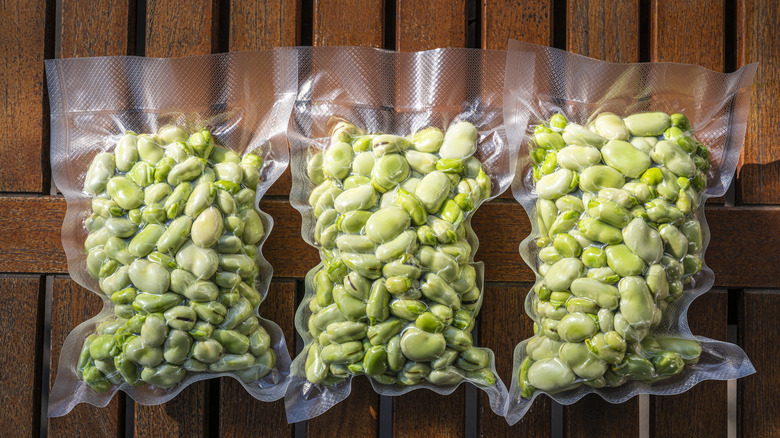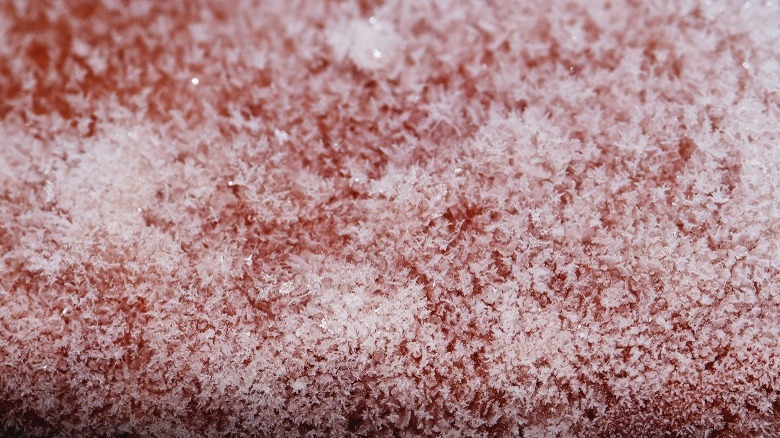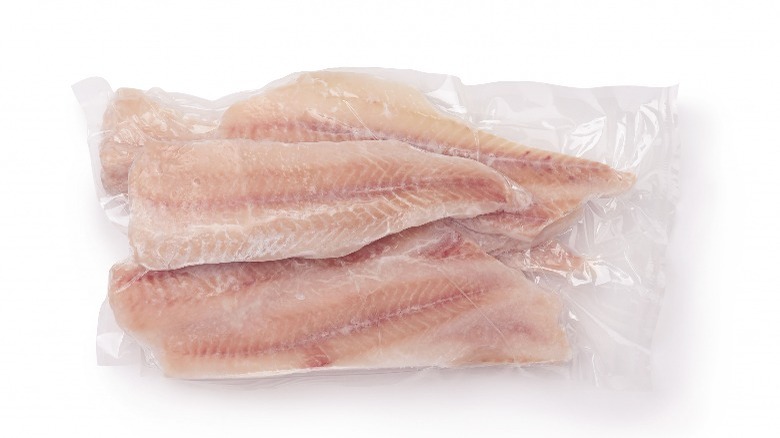How To Properly Seal Frozen Food Without A Vacuum
Vacuum sealing makes a world of a difference for food placed inside a freezer, helping to prevent freezer burn and significantly lengthening the amount of time that the food can last. For this reason, it's common to see grocery stores packing their fresh meat in airtight containers, though that's not always the norm, especially when purchasing cuts directly from a butcher, for example. While vacuum sealer machines are available for the home market, their bulky size and expensive price tag keeps them from becoming a mainstay of most kitchens. But, luckily, there are other, more DIY ways to seal foods tightly and keep them fresh when frozen, even without a vacuum — and all you need is a zip-top bag and some water.
The best way to ensure a tight seal is to enclose the food inside of a zip-top bag, preferably ones specifically labeled as freezer bags. Regular, sandwich-sized ones will do fine in a pinch, too, but they're not as thick and thus more prone to ripping and tearing. Using this freezer bag method, you'll want place the food inside in a single, even layer, and slowly press the air out while also sealing the top — this will keep the contents nice and cozy. Don't zip all the way, though; instead, leave a small opening, about 1-inch in length, and then submerge the bag in a pot of water, pressing out air bubbles that have popped up. Once the food is packed in tight, seal the bag fully closed.
It's a great way to fight against freezer burn
Vacuum-sealing food before freezing it is vital to prevent freezer burn, which is what happens when food is not wrapped tightly enough and is then exposed to frigid cold air as moisture inside the food turns into ice crystals in these below-freezing environments. If the food is kept in the freezer for a prolonged time, the process is even more likely. Though it doesn't make it dangerous to eat, the increase of oxygen (and lack of moisture) makes the food dehydrated, leaving an unpleasantly stale taste and discoloring that can't be reversed.
Placing your leftovers or overstock in an airtight container, then, is one big way to avoid this tragedy. The more tightly packed the food is, the less room there is for the water molecules to escape. At the same time, if there's no air in your airtight container, there's no oxygen to seep in and ruin the food. It also helps to freeze contents as quickly as possible to solidify everything before moisture can create mounds of ice crystals that might dry out the meal when thawing occurs.
Some rules when it comes to sealing food
It's important to note that not all food can be sealed with an airtight container in the same way. Cruciferous vegetables like broccoli, Brussels sprouts, cabbage, kale, and bok choi naturally secrete a gas that will expand any bag you place them in them, rendering the airtight seals useless. Freezing will help prevent this reaction from happening, but blanching these veggies first never hurts, especially since the gas will return as soon as the thawing starts.
The same goes for mushrooms, which retain their texture better if they're cooked before going into the freezer in a tight seal bag. Make sure anything that's cooked is at room temperature before sealing it, too, since hot steam can also create air that will expand the bag.
In some cases, it's actually safer to forego vacuum sealing altogether. Soft and unpasteurized cheeses can grow harmful mold faster in an airtight environment, so avoid sealing Brie, ricotta, goat, or blue cheeses. Besides, freezing cheese ruins the texture, anyway. In addition, although raw fish is perfectly safe to have an airtight seal, it can grow the bacteria that causes botulism when placed in airless environments and in temperatures above freezing. That means you must remove it from the bag when thawing it out in the fridge.
Don't be too scared to super seal most foods, though; it's an easy and painless process that can make frozen foods taste like they were just purchased.



